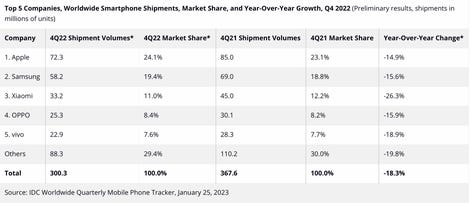Smartphone shipments in the fourth quarter of 2022 fell 18.3% year-on-year to 300.3 million units. This is the largest quarterly decline on record, according to IDC.
The fourth quarter is historically strong for smartphone sellers. But this year, he did not keep his promises. The 18% decline contributed to an 11.3% decline for the year as a whole.
Smartphone vendors shipped 1.21 billion smartphones in 2022, which IDC says is the lowest level since 2013. The reason? Customers are tightening their belts, inflation is here and the economic outlook is unstable.
“We have never seen Q4 deliveries be lower than the previous quarter”
Even Apple, which gained market share with the launch of the iPhone 14 series in September, saw shipments decline 14.9% year-on-year, from 85 million to 72.3 million. Apple will share its fiscal first quarter 2023 results next Thursday. In November, the company warned that iPhone 14 shipments would be lower during the holiday season due to COVID-19 restrictions imposed by China at its main iPhone assembly site in Zhengzhou.
According to IDC, given the economic uncertainty, smartphone sellers preferred to dip into their inventory as they went rather than stocking sellers’ shelves.
“We have never seen Q4 shipments be lower than the previous quarter. However, weaker demand and high inventory levels caused suppliers to significantly reduce shipments,” said Nabila Popal, Director of research at IDC Worldwide Tracker.
Smartphone refresh rate exceeds 40 months (3.3 years)
“Heavy sales and promotions in the quarter helped to deplete existing inventory rather than drive shipment growth. Suppliers are increasingly cautious in their shipments and planning while focusing on profitability. Even Apple , which until now seemed immune, suffered a setback in its supply chain with unforeseen blockages at its main factories in China.What this last quarter tells us is that rising inflation and Macroeconomic concerns continue to dampen spending even more than expected and push back any eventual recovery until the very end of 2023.”
Another analyst, Canalys, said global smartphone shipments in the fourth quarter of 2022 fell 17% year-on-year, while full-year shipments fell 11% to just under 1.2 billion devices sold.
Anthony Scarsella, research director at IDC Worldwide Quarterly Mobile Phone Tracker, says smartphone refresh rates exceed 40 months (3.3 years) in most major markets.
Deliveries from the top 5 suppliers decreased by 15% to 26%
A growing segment is second-hand and refurbished smartphone shipments. In 2022, used smartphone shipments increased 11.5% year-on-year to 283 million. In other words, second-hand smartphone shipments exceed new smartphone shipments. The market is driven by vendors such as Apple promoting trade-in programs to accelerate sales of new smartphones, often by offering higher trade-in values.
Mr Scarsella believes that 2023 could be a good year for those looking to trade in a relatively new phone for a newer one.
“With a decline of more than 11% in 2022, 2023 is shaping up to be a year of caution as vendors rethink their device portfolios while distributors think twice before taking on excess inventory. However, and on a positive note, customers may find even more generous trade-in offers and promotions in 2023 as the market thinks about new ways to boost sales, especially of higher-end models.” Mr Scarsella.
Shipments from the top five vendors fell 15% to 26% year-on-year in Q4 2022. Apple leads the pack with 72.3 million iPhones, followed by Samsung with 58.2 million, a drop of 15.6%. Xiaomi shipments fell 26.3% to 33.2 million. Oppo and Vivo complete the top 5 with 25.3 million and 22.9 million units, respectively.
For the full year, Samsung leads with 260.9 million shipments, followed by Apple with 226.4 million. Xiaomi, Oppo, and Vivo shipped 153.1 million, 103.3 million, and 99 million units, respectively.

Source: IDC
Source: “ZDNet.com”
